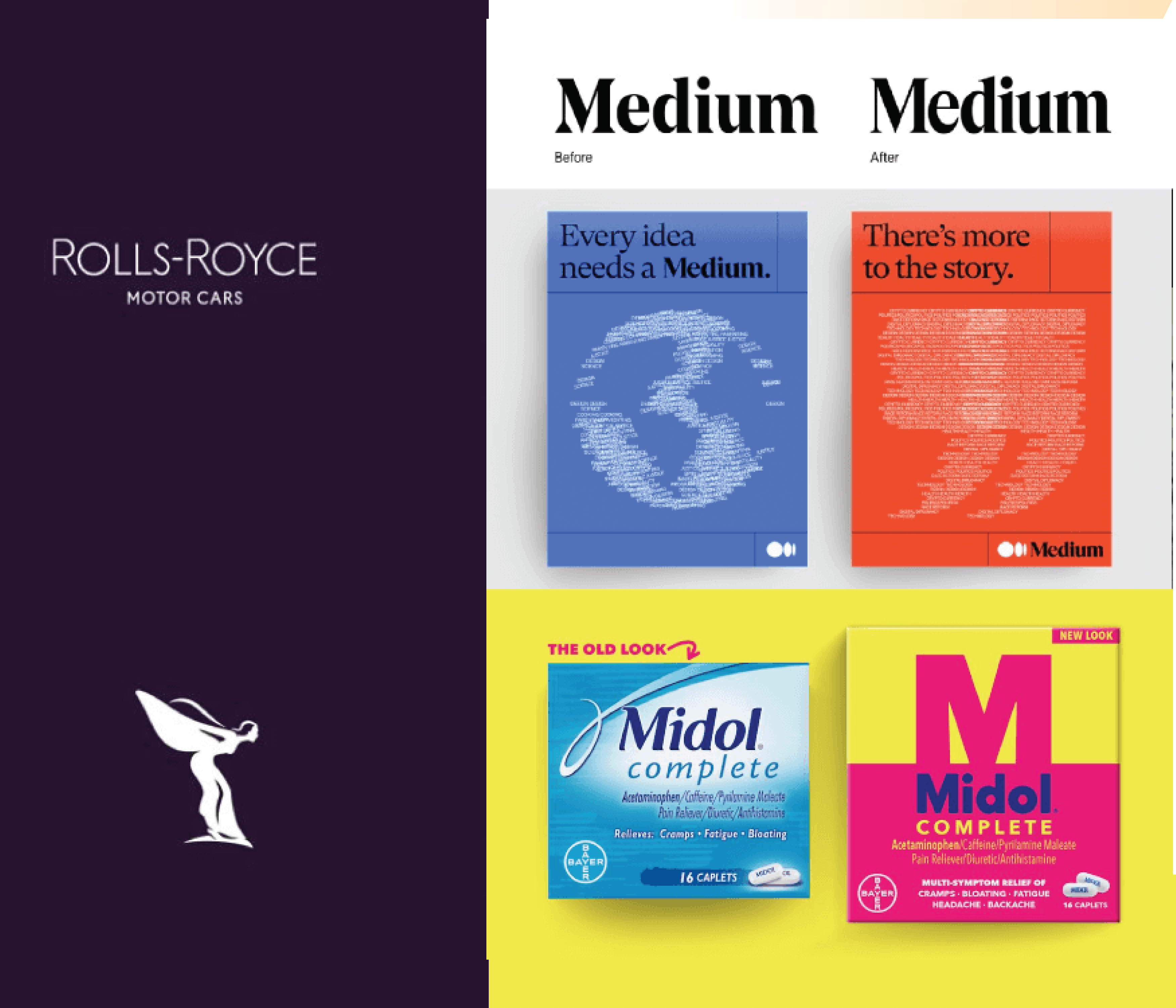A great brand name is not just something that looks cool on your business card or is fun to say. And it isn’t great because you like it. It’s great because it communicates something to customers.
Marty Neumeier, the branding pro, summed it up well. Customers need easy ways to spot, recall, chat about, and weigh up different brands. The right name makes you stand out and speeds up acceptance. In fact, brand names can count for a third of brand value, according to Nielsen. And 77% of consumers say a brand name impacts buying decisions.
That means the stakes are high when it comes to choosing the right name, and generic name generators aren’t going to help you find one in an instant. What you need is a process for finding a strategic, authentic brand name without taking ages. Luckily, we’ve helped brands of all sizes find the right name, so we know the process and can guide you through it.

What Makes a Good Brand Name?
There are plenty of theories and a few studies on what makes a good name. For example, a 2010 University of Alberta study found that consumers have a more positive reaction to brands with repetitively structured names, such as Coca-Cola, Kit Kat, and Jelly Belly.
While there is no magic formula, there are common traits that make a brand name easier for you to use and easier for other people to remember. Ideally, you want something that’s:
- Meaningful: It communicates your brand essence, conjures an image, and cultivates a positive emotional connection.
- Distinctive: It is unique, memorable, and stands out from your competitors.
- Accessible: People can easily interpret it, say it, spell it, or Google it. (Even if you have an unusual or bizarre name, it must be understandable.)
- Protectable: You can trademark it, get the domain, and “own” it, both legally and in the general consciousness.
- Future-proof: It can grow with the company and maintain relevance—and be adapted for different products and brand extensions.
- Visual: You can translate/communicate it through design, including icons, logos, colors, etc.
This is useful criteria to help you vet names, but there is really one question to determine whether a name is successful (note that we didn’t say “good” or “bad”). All that matters is this: Does it resonate with people?
How to Find the Right Brand Name
Finding a good brand name can be exhausting, infuriating, and thrilling. (Warby Parker Cofounder Neil Blumenthal says it took his team six months and 2,000+ options to find the perfect name.)
There are more and more services that are trying to make it easier for you, whether by pre-vetting and suggesting names (e.g., Shopify’s Business Name Generator or Wordoid), domains (e.g., Bust a Name) or names and available URLS (e.g., Brand Bucket).
These tools can be helpful for brainstorming, but we think it’s important choose, vet, and test a brand name intentionally and with purpose. (Some things just can’t be auto-generated.)
So, if you’re ready to choose your brand name, here’s our step-by-step guide to do it. For additional insights, check out our five-step guide to choosing a brand name.
Step 1: Articulate Your Brand Heart
Before you name yourself, you need to understand who you are and what you’re trying to achieve. To do this, you need to articulate your Brand Heart. This includes:
- Purpose: Why do you exist?
- Vision: What future do you want to help create? What does the future look like?
- Mission: What are you here to do? How do you create that future?
- Values: What principles guide your behavior?
Combined, these elements influence everything you do (including choosing a name). If you don’t know the answers to these questions, follow our guide to find your Brand Heart, and download our free workbook template below.

Step 2: Look at Your Differentiators
Understanding what makes your brand unique is the key to finding a brand name. Your Brand Heart is certainly one thing that makes you unique, but there are also plenty of other things about your business that make you standout. You want to keep these differentiators front of mind as you move through the naming process. Remember: You aren’t just looking for a great name. You’re looking for a great name for you.
If you don’t have a firm grasp on what makes you different, follow our guide to complete a competitive analysis (which includes a free template to make the process easier). By looking at your competition, you get a better sense of how you can stand out through every aspect of your branding.
Step 3: Brainstorm
Here’s the fun (and sometimes brutal) part. Gather your stakeholders and creatives and host a structured brainstorm. While it sounds fun to let everyone go wild, it’s more effective to provide some sort of guidelines or constraints to work within. You may want to start these discussions with certain prompts or specific exercises. For example:
- Write down all the adjectives that describe your product/service.
- Describe what you want your customers to feel when they use your product/service.
- Do a free association of words about your product/service.
Another useful way to brainstorm is to think of the different categories of brand names. As outlined by Alina Wheeler in Designing Brand Identity, these include:
- Founder: A name based on a real or fictional person, such as Ben & Jerry’s, Warby Parker, or Betty Crocker.
- Descriptive: A name that describes what you do or make, such as General Motors.
- Fabricated: A totally made-up name or word, such as Kodak, Xerox, or TiVo.
- Metaphor: Mythical, foreign, or imagery-heavy things, places, people, animals, or processes, such as Nike or Patagonia.
- Acronym: A name that uses initials or an abbreviation, such as DKNY (Donna Karan New York) or GE (General Electric).
- Magic spell: A name that is a portmanteau (two words together) or a real word with a made-up spelling, such as FaceBook or Flickr.
Challenge your team to come up with a name for every category. You’ll probably start to see a trend or preference for one type over the other. Try to come up with 15-20 names.
A few extra hacks:
- Use Onym for more naming exercises, word etymologies, vetting tips, and a ton of other stuff to help you find the best brand name.
- Use Panabee to search domain names, app names, and company names, get alternate suggestions, and see related terms.
- Try these tips to get unstuck if you’re running out of steam.
You can also take a look at our tips for better brainstorms to make your process more productive.
Step 4: Vet Your Brand Name
This is absolutely the most frustrating part. There’s no point in testing anything that’s already taken, so you need to vet your frontrunners.
Narrow your brainstormed list down to the team favorites (ideally those 15-20), then search the United States Patent and Trademark Office’s database of registered trademarks. (While you’re there, check out their guide to trademark basics.) If they’re all taken, it’s back to the drawing board. This exercise will surely winnow your list down for you. But if you’re a genius who has somehow found 20 unregistered names on the first try, narrow it down to your top three to test.
Note: If a name appears to be available, get a legal team to fully vet it.
Step 5: Test, Test, Test
Now that you’ve cleared the legal hurdle, here comes the most exciting part. You get to create your mockups (think logos, product packaging, and homepages), and test your top three names. You may be surprised at what resonates with people.
Here’s one simple and easy testing idea, courtesy of startup lawyer Steven Cook:
- Build a branded landing page for each name. Use identical copy and only change logo/brand name.
- Run a highly targeted FB ad to your target customers for a week.
- See which page got more conversions.
Once you’ve done this exercise, you should have a frontrunner. (If two names are tied for conversions, let your brand team make the final call.)
How to Complete Your Brand
Your brand name is only the first step in building a strong, memorable brand. From name, to messaging, to your visual identity, you want to approach your brand thoughtfully and strategically.
Once you have your name, you can work on completing your brand:
- Download our free brand strategy toolkit. This gives you all the tools you’ll need to complete a brand strategy.
- Build out your messaging. Follow our guides to find your voice, personality, tagline, value prop, and brand messaging pillars.
- Design a strong visual identity. Follow our step-by-step guide to build a solid visual identity, see our tips to make it memorable (according to science), and use our handy visual identity checklist to make sure it’s complete.
- Create useful brand guidelines. Don’t let all your hard branding work go to waste. Learn how to create comprehensive and easy-to-use brand guidelines to ensure your team applies your brand correctly every time.
- Use your branding in your content. Branding is simply a tool to help you communicate who you are. Find out how to tell your brand story through creative content, and how to optimize your content creation process.
Remember, too, that your brand name is just the start. The real challenge is communicating your brand story across channels. Column Five has helped brands like Instacart and Dropbox connect with their audiences via quality, scalable content—and we can do the same for you, too. If you want to learn more, talk to a Column Five brand strategist about how we can help you build a winning brand from the ground up.





This is a excellent blog, will you be interested in doing an interview about just how you created it? If so e-mail me!
This website does not show up appropriately on my iphone 3gs – you might wanna try and fix that
Thanks for the heads up. Is it images or layout issues that you’re seeing — and what browser are you using?
Hello just wanted to give you a brief heads up and let you know a few of the pictures aren’t loading correctly. I’m not sure why but I think its a linking issue. I’ve tried it in two different internet browsers and both show the same results.
Thanks for the heads up! Will look into it.
I want to create a good brand name
Thank you
It was helpful
Brand’s
Great article! Choosing the perfect brand name is crucial for any business, and these 5 simple steps provide a clear guide to navigate through the process. I particularly appreciate the emphasis on practicality and memorability. Using a reliable name checker tool mentioned in the article can definitely streamline the decision-making process and ensure the chosen name is unique and resonates well with the target audience. Thanks for the insightful tips!
https://namecheckerr.com/
I would like to open a project to support my family in my small town we decided to open a family restaurant for Arabic food and drinks only
Thank you for informative article.
Happy to help!
Hi, It’s a fantastic article written with useful information that will aid in the development of a brand name for any organization. It will be very beneficial if you can offer a brand name for my business, “My library and café,” as it will aid me in gathering information and evaluating many factors when choosing a name. Thank you for the useful essay.
Thank you for sharing your knowledge in this article. This will be very helpful for business work in terms to develop a brand name.
Glad to hear it!
Want to make sportswear brand
Require help to fine out product names
I want a good brand name for my business
Thinking of a better brand name, as a fashion designer.
I won’t to brand
Need a good brand name of the foods products.
Hope this was helpful.
Trying to come up with a name for a wreath making business that I run out of my home now and I am at a loss. Just starting out.
Thanks,
Tina Harris
Hope this gives you some helpful tips! Best of luck.
i want to need a brand name.
Very beautiful
I love ur website
Thanks so much!
I need help for branname
I’m trying to make my brand name my own and was woundering the best way to do that so I can start my own business
Thanks for answering my question
Happy to help.
Its good
I love the tips you guys gave to me, it’s perfect
So happy to help!
Just need a beautiful brand name for my business
Brand name
This was very helpful, as someone who has never done, or being a part of business. This was very helpful.
So happy to hear that!
I need Diffrent new and unique brand name fir cosmetics and skine care
I’m very happy that I landed here.thank you for the great post.
Happy to help!
Thanks for sharing this blog. Thanks for sharing this blog. A fantastic business name will help customers quickly connect your brand to the products or services you sell. They create anticipation for your business and set the stage for growth.
Thanks for reading!
Amazing
Hope it helps!
need good name to lauch new brand of bags
Hope I can learn more and get a lot of free tips
Soft drinks name
I need a good name
Name my brand
I need a good name